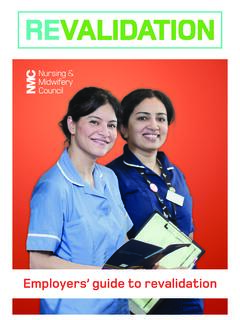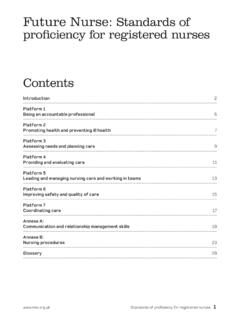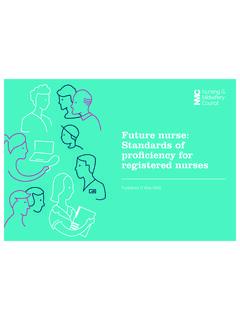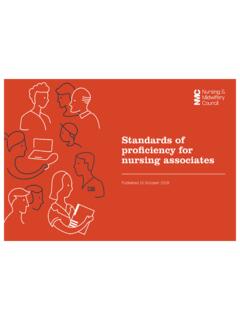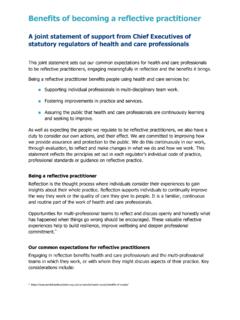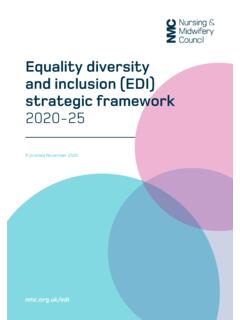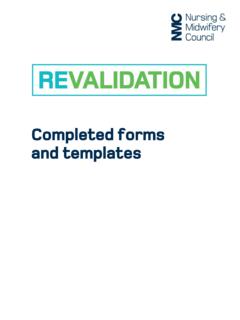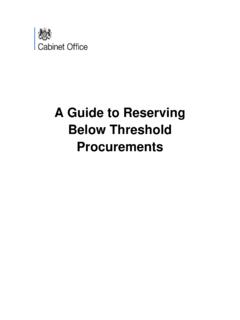Transcription of NMC equality and diversity strategy
1 Nursing and Midwifery Council equality and diversity strategy Introduction We are the nursing and midwifery regulator for England, wales , Scotland, northern ireland and the Islands. We exist to safeguard the health and wellbeing of the public . We set standards of education, training, conduct and performance for nurses and midwives, and hold the register of those who have qualified and meet those standards. We provide guidance and advice to help nurses and midwives keep their skills and knowledge up to date and uphold our professional standards. We have clear and transparent processes to investigate and deal with nurses and midwives who fall short of our standards.
2 Our remit is set out in the Nursing and Midwifery Order 2001 and our work is governed by this and other associated legislation. Our vision is to safeguard the public by ensuring nurses and midwives consistently deliver high quality healthcare. About this strategy As a public body, as a regulator and as an employer we have an important role to play in promoting equality and diversity throughout the UK. This strategy is based on our values of accountability, fairness, professionalism, progressiveness and inclusiveness, and sets out our commitment to embedding equality and diversity at the heart of our activities.
3 We are proud to contribute to creating a society in which people are treated fairly and are valued for their diversity , irrespective of age, disability, gender re-assignment, marriage and civil partnership, pregnancy and maternity, race, religion or belief, sex, and sexual orientation. We aspire to move above and beyond legislation to become an example of good practice within healthcare regulation by eliminating discrimination and advancing equality and diversity in our work. The equality Act 2010 The equality Act came into operation on 1 October 2010. The equality duty was created by the equality Act and replaces the race, disability and gender equality duties.
4 The duty came into force in April 2011 and covers age, disability, gender, gender reassignment, pregnancy and maternity, race, religion or belief and sexual orientation. These are referred to as protected characteristics. The equality Act only applies in England, Scotland and in wales and not in northern ireland and the Islands. We will show due regard to equalities in northern ireland and the Islands in the delivery of our diversity strategy . November 2011 Page 1 of 7 November 2011 Page 2 of 7 Further information and guidance about the equality Act can be found from the Government Equalities Office at: or the Equalities and Human Rights Commission The equality duty requires us, as a public body, in the exercise of our functions, to have due regard to the need to: Eliminate unlawful discrimination, harassment, victimisation and other conduct that is prohibited by the equality Act.
5 Advance equality of opportunity between people who share a protected characteristic and those who do not. Foster good relations between people who share a protected characteristic and those who do not. Due regard for advancing equality involves: Removing or minimising disadvantage suffered by people due to their protected characteristics. Taking steps to meet the needs of people from protected groups where these are different from the needs of other people. Encouraging people from protected groups to participate in public life or in other activities where their participation is disproportionately low.
6 Our commitment to equality , diversity and inclusion We are fully and wholly committed to promoting equality , diversity and inclusion in carrying out all our functions and in delivering our services as a public body, as a regulator and as an employer. Below we set out our commitment to equality and diversity . We will value and embrace differences and individuality in our stakeholders that is, our staff, our Council members, our partners who work on our behalf, nurses and midwives, and the public we serve. Our aim is to ensure that all of our stakeholders receive a high level of service from us, and that everyone is treated fairly.
7 We will understand how our activities, services and functions impact on diverse groups, enabling us to eliminate unlawful discrimination related to the protected characteristics. We will ensure that equality and diversity is embedded throughout our work, and that our staff and partners who work on our behalf are aware of their accountabilities and responsibilities in relation to the equality Act. November 2011 Page 3 of 7 We will take a decisive leadership role in ensuring that equality , diversity and inclusion are at the forefront of our agenda, and within our scope of work, influence and expertise.
8 We will ensure that dedicated resources are available to promote and facilitate the delivery of our equality and diversity objectives. What we are required to do Publish information that demonstrates our compliance with the equality Act As a public body, we are required to publish information that demonstrates our compliance with the equality Act. This information must show the effects that our policies and practices have had on people who share protected characteristics. It must also show the extent to which our policies and practices have furthered the aims of the equality Act for our stakeholders.
9 We must publish information about: Analysis that has been undertaken to establish whether our policies and practices have furthered, or have the potential to further, the aims of the equality Act. Information that has been considered during the analysis. Engagement that has been undertaken with people who have an interest in furthering the aims of the equality Act. Publish equality objectives By April 2012 we must prepare and publish equality objectives that outline how we will meet the requirements of the equality Act for the year(s) ahead.
10 equality objectives will help us to improve the focus and transparency of our activity in meeting the equality Act. When choosing our priorities, we have considered issues of harassment, discrimination, equality and good relations across all of our policy, service delivery and employment functions. It is important to demonstrate the progress that is being made towards achieving our equality objectives. Our objectives must be specific and measurable and set out how progress will be measured. They will be measured and reported against, in order to increase transparency and accountability.
